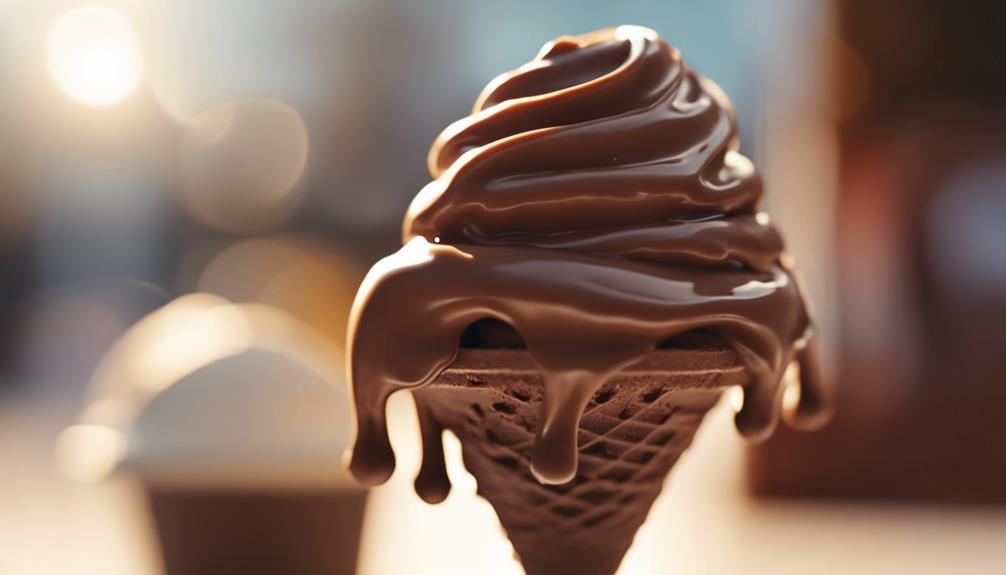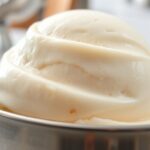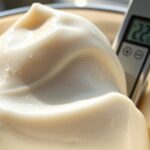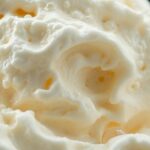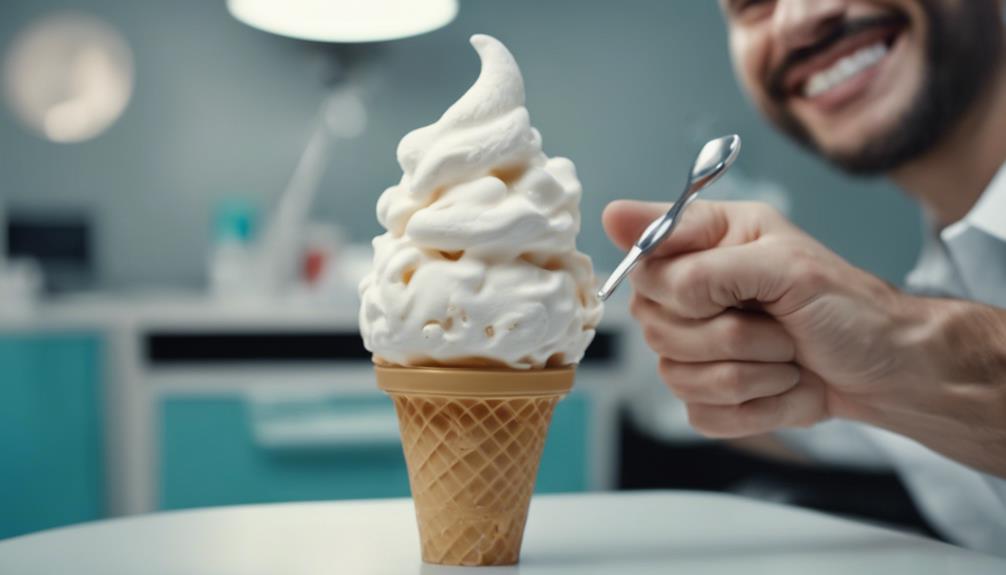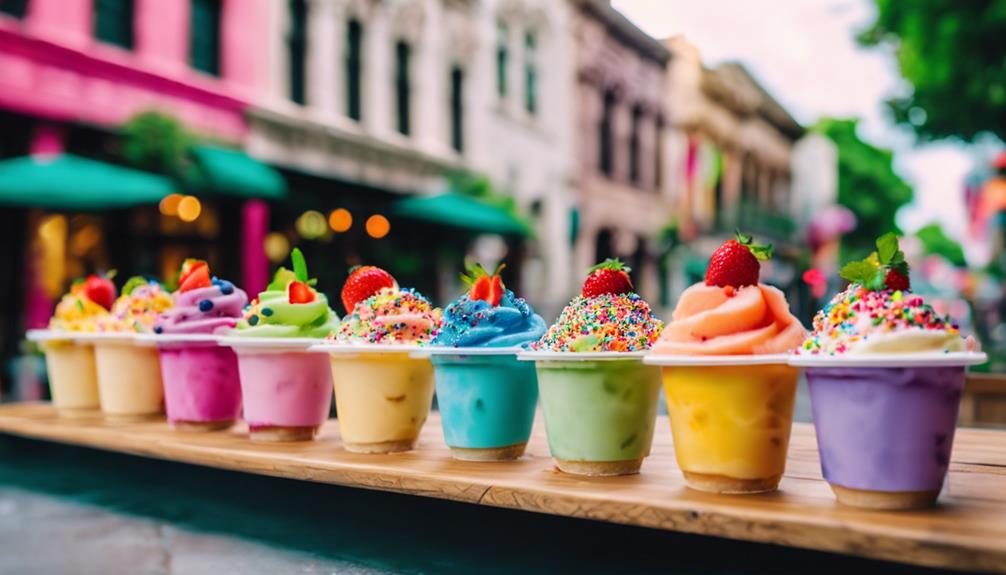When ice cream melts, heat causes its composition to deteriorate. This results in fat globules destabilizing, air cells collapsing, and ice crystals dissipating. The temperature, fat content, and air ratios all play a role in determining how rapidly your ice cream transforms into a creamy mess. If you’re interested in delving deeper into the scientific explanation behind this delicious metamorphosis and discovering ways to avoid it, there’s plenty of fascinating information for you to explore!
Key Takeaways
- Structural breakdown occurs due to heat exposure.
- Fat globules destabilize, air cells collapse.
- Ice crystals dissolve with increased temperature.
- Proportions of air, ice crystals, and fat affect melting rate.
- Connections holding ice crystals weaken, accelerating melting.
Ice Cream Melting Process

To understand how ice cream melts, focus on the breakdown of its structural components when exposed to heat. The melting process involves the destabilization of fat globules, collapse of air cells, and dissolution of ice crystals. Understanding the breakdown of these structural components is crucial in understanding why ice cream melts the way it does. In fact, the ratios and types of these components can vary between different types of ice cream, leading to variations in melting rates and texture. For example, what is salty ice cream contains higher levels of fat, which can result in a creamier and slower-melting product compared to regular ice cream.
The rate at which ice cream melts is influenced by the proportions of air, ice crystals, and fat content within the mixture. Higher temperatures accelerate the melting process by speeding up the dissolution of ice crystals.
When heat exposure occurs, the fat content in ice cream plays a pivotal role in determining how quickly it will melt. Fat globules within the mixture start to lose stability, leading to a softer consistency as they break down. Additionally, the air cells present in ice cream collapse under heat, contributing to its overall melting process.
Temperature Impact on Melting
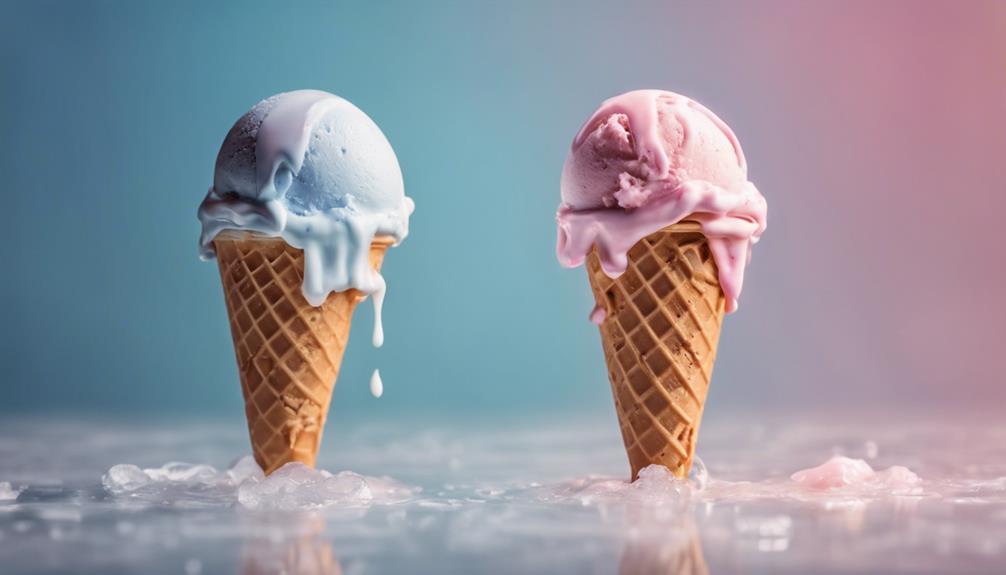
Higher temperatures speed up the melting process of ice cream, causing it to lose its structure and consistency more rapidly.
When exposed to heat, ice crystals melt faster, leading to the collapse of the ice cream.
On hot days, the increased temperature accelerates the softening of ice cream and affects its overall melting rate.
Temperature and Melting
Hot temperatures significantly speed up the melting process of ice cream, causing it to lose its form and collapse more rapidly. When the temperature increases, the heat energy moves to the ice cream, leading to a quicker melting rate.
The heightened heat exposure on hot days softens the ice cream, making it more susceptible to melting rapidly. Temperature plays a crucial role in determining the texture and melting speed of ice cream. As the heat increases, the connections holding the ice crystals together weaken, hastening the melting process.
This acceleration in melting due to higher temperatures can be observed as the ice cream shifts from a solid to a liquid state. Consequently, the structure of the ice cream breaks down faster under warmer conditions, eventually resulting in a softer and more liquid texture.
Heat's Melting Effects
When temperatures rise, the impact on ice cream melting becomes more pronounced. Heat plays a pivotal role in the melting process, affecting the ice cream's structure, consistency, and melting rate.
As the temperature increases, the heat causes the ice cream to rapidly soften, leading to a quicker melting rate. Higher temperatures result in faster ice crystal melting and a more rapid collapse of the ice cream's composition.
On hot days, ice cream is particularly susceptible to melting due to the increased heat exposure. The consistency of the ice cream is greatly influenced by the surrounding temperature, with warmer environments causing it to soften and lose its structure more rapidly.
Understanding the effects of heat on ice cream melting can help in better preserving its texture and form, especially in warm weather conditions.
Preventing Melting Techniques

To prevent your ice cream from melting quickly, you can try using insulated containers like Calicle bowls or dry ice and freezer packs. These methods effectively block heat transfer, keeping your ice cream cold for longer periods.
Additionally, utilizing pre-frozen bowls or storing your ice cream properly in hot weather can help maintain its texture and consistency.
Melting Prevention Methods
Insulating bowls, such as Calicle bowls, serve as effective tools in delaying ice cream melting by impeding heat transfer. To prevent ice cream from melting quickly, consider these practical methods:
- Utilize Dry Ice and Freezer Packs: Placing dry ice or freezer packs around the ice cream container can help maintain a lower temperature, slowing down the melting rate.
- Store in Airtight Containers: Keeping ice cream in airtight containers minimizes exposure to warm air, preserving its texture and preventing premature melting.
- Pre-freeze Bowls or Containers: By pre-freezing the bowls or containers where you plan to serve the ice cream, you can extend the frozen state of the dessert, delaying the softening process caused by heat transfer.
Delaying Ice Cream Melting
By employing various techniques, you can effectively delay the melting of ice cream and prolong its frozen state for a more enjoyable treat. The fat content in ice cream plays an essential role in its melting rate. Ice cream with higher fat content tends to melt more slowly due to its ability to hold air cells and ice crystals more efficiently.
Using insulated bowls, like Calicle, can help by reducing heat transfer and maintaining a cooler temperature. Additionally, storing ice cream in insulated containers or utilizing dry ice and freezer packs can significantly slow down the melting process.
Understanding the composition of ice cream, including its freezing point and the impact of heat transfer, can guide you in selecting the best methods to prevent rapid melting. Proper storage techniques and keeping the top surface of the ice cream cool can also aid in delaying the overall melting rate, allowing you to savor your frozen treat for a longer period.
Factors Affecting Melting Rate

Factors such as temperature, fat content, stabilizers, and sugar content play an important role in determining the melting rate of ice cream.
- Fat Content in Ice Cream: Ice cream with lower fat content tends to melt faster due to less fat acting as an insulator, allowing heat to penetrate the ice cream more quickly.
- Stabilizers Used: When stabilizers like gelatin or guar gum are added during the process of making ice cream, they help create small ice crystals and lower its freezing point. This results in a slower rate of ice cream melting.
- Formulation and Storage: Different formulations and storage conditions impact the melting rate of ice cream. Brands with higher fat content and stabilizers in their formulations tend to melt slower compared to those with lower fat content and fewer stabilizers. Proper storage techniques, such as keeping ice cream in a freezer at -18°C and using airtight containers, can also help delay the melting process.
Control Techniques for Melting
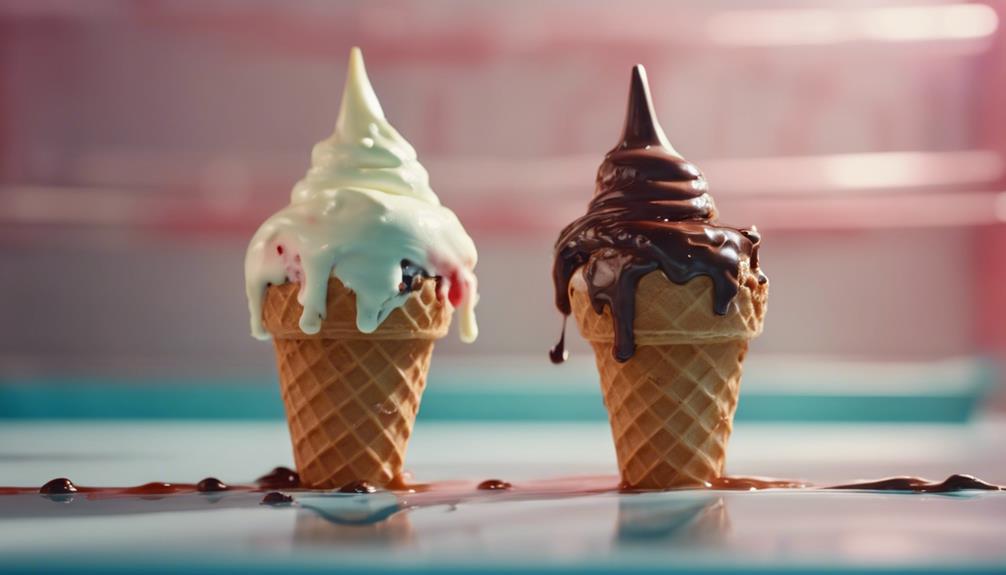
Adjusting elements like fat content, air cell size, and structural features can impact the melting speed of ice cream.
By adjusting overrun, rotor speed, and viscosity, you can effectively manage how fast your ice cream melts.
Increasing fat content and optimizing structural features can help slow down the melting process. Additionally, enhancing overrun and encouraging small air cell formation can further prolong the time it takes for your ice cream to melt.
Managing air bubble size through modifications in rotor speed and viscosity is also vital in influencing the melting speed.
Taking into account factors like ice crystal size and total solids content is crucial for achieving the desired control over your ice cream's melting characteristics.
Partial Fat Coalescence

During dynamic freezing in ice cream production, partial fat coalescence is an important process that influences the texture and stability of the final product. Here's why it matters:
- Protein and Emulsifiers: These components in ice cream can impact fat destabilization, which in turn affects partial fat coalescence. The presence and interaction of protein and emulsifiers play a significant role in determining the texture and stability of the ice cream.
- Fat Globule Clusters: Fat globule clusters within ice cream are essential for stabilizing air bubbles. Understanding how these clusters form and interact during dynamic freezing is vital for achieving the desired texture and consistency in the final product.
- Aging Influence: As ice cream ages, partial fat coalescence continues to occur, influencing the overall stability of the product over time. The process of aging can alter the texture of the ice cream, making it essential to manage fat coalescence effectively from production to consumption.
Ingredient Influence on Melting

Understanding how ingredients like sweeteners and emulsifiers impact the melting rate of ice cream is essential for achieving the desired texture and consistency in the final product.
Sweeteners such as fructose and glucose syrup can influence how quickly ice cream melts. Emulsifiers like polysorbate 80 play a role in stabilizing the mixture and affecting the melting rate.
Different syrups, such as 20 DE corn syrup and 42 DE high fructose corn syrup, can also impact how fast ice cream melts.
Additionally, the presence of stabilizers, structural components, and freezing conditions all contribute to determining the melting rate of ice cream. With the addition of stabilizers, such as xanthan gum or guar gum, the melting rate of the ice cream can be slowed down, allowing for a more enjoyable eating experience. Furthermore, the structural components of the ice cream, such as air whipped into the mixture, can influence how quickly it melts. Additionally, freezing conditions, such as the temperature of the freezer and the way the ice cream is stored, also play a role in determining its melting rate.
Steps to take if plastic found: If plastic is found in the ice cream, it is important to remove the plastic immediately and thoroughly inspect the product for any further contamination. It is also important to contact the manufacturer and the store where the ice cream was purchased to ensure that proper measures are taken to prevent similar incidents in the future.
Adjusting the proportion of fat, air cells, and ice crystals in the ice cream can help control how quickly it melts.
Freezing Conditions' Effects

Freezing conditions greatly affect the crystallization, texture, and resistance to melting of ice cream. When ice cream is subjected to freezing conditions, several key aspects come into play:
- Crystals Formation: The speed at which ice cream freezes impacts crystal formation. Slower freezing leads to larger ice crystals, resulting in a grainy texture, while faster freezing forms smaller crystals for a smoother consistency.
- Fat Content Influence: The amount of fat present in ice cream affects its ability to resist melting. Higher fat content can lead to a creamier texture that melts more slowly, providing a richer mouthfeel.
- Air Content Impact: The quantity of air incorporated during the freezing process affects the overall structure of the ice cream. More air results in a lighter texture, while less air produces a denser and heavier product.
Understanding how freezing conditions interact with factors like fat content and air content is essential in controlling the texture, melting properties, and overall quality of ice cream.
Types and Melting Rates
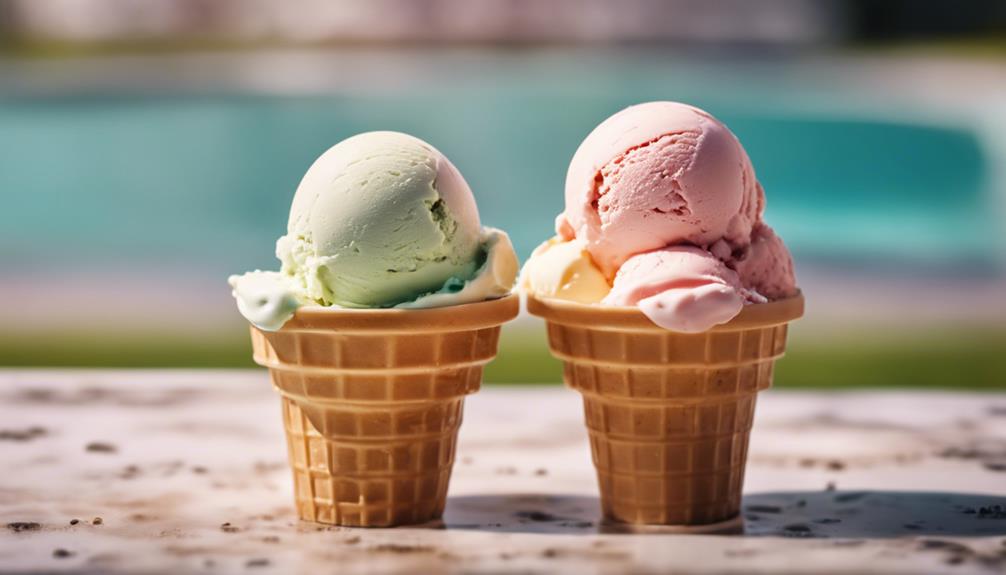
Different types of frozen treats, such as ice cream, gelato, and sorbet, exhibit varying melting rates due to their distinct compositions and ingredients.
Ice cream, with its higher dairy fat content, tends to melt slower than gelato and sorbet.
Gelato, containing less dairy fat than traditional ice cream, generally melts at a slower rate due to its specific composition.
On the other hand, sorbet, which lacks dairy fat entirely, typically has the fastest melting rate among the three varieties.
Factors such as fat content, stabilizers, and formulation play significant roles in influencing the melting properties of these frozen treats.
Different brands and formulations of ice cream can impact melting rates based on their unique ingredient combinations.
Understanding these differences in melting rates can help you choose the frozen treat that best suits your preferences for texture and consistency.
Frequently Asked Questions
What Is the Science Behind Ice Cream Melting?
Understanding the science behind ice cream melting involves a delicate balance of ingredients and temperature control. Factors like fat content, stabilizers, and air content influence how quickly your treat transforms from a scoop to a pool.
What Happens Scientifically When Ice Melts?
When ice melts, magic happens! It transforms from solid to liquid by breaking down its structure. Molecules go wild, dancing freely. Temperature rules all, shaping its destiny. So, bask in the marvel of science at play!
What Changes Happened to Ice Cream After Melting?
Once ice cream melts, its texture shifts, flavors may disperse unevenly, and it becomes more vulnerable to temperature changes. The taste, consistency, and overall sensory experience can be altered, affecting your enjoyment of the treat.
What Happens When Ice Cream Is Heated to Its Melting Point?
When you heat ice cream to its melting point, a delicious transformation occurs. Ice crystals surrender, fats flow freely, and trapped air bubbles escape. Watch as your frozen treat surrenders its shape to become a luscious liquid delight.
Conclusion
So, next time you see your ice cream starting to melt, remember that it's all due to the temperature around it!
But don't worry, there are plenty of ways to slow down the melting process and enjoy your treat for longer.
Keep experimenting with different techniques and conditions to find the perfect balance between creamy goodness and melting mess.
And who knows, maybe you'll even uncover some new discoveries along the way!
